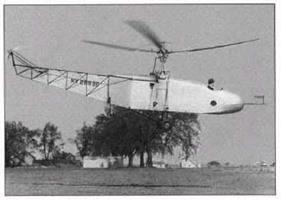Taming the Wild Rotor
The more you learn about rotary-wing aerodynamics and construction, the more you come to one conclusion: It’s an absolute miracle that helicopters ever manage to get off the ground.
|
It may not have been a thing of beauty, but the VS-300 could boast the first practical helicopter design. Note the distinctive fedora hat worn by test pilot Igor Sikorsky. |
|
|
As with so many pioneering aircraft, helicopters took off in popularity
thanks to the military. The armed forces first put helicopters like the
Sikorsky HNS-1 to work on rescue missions, and later added weapons and
high-technology devices.
If that’s true, then Igor Sikorsky was a miracle worker. In creating the first workable helicopters, Sikorsky had to do two things. He had to master the enormous complexity of a functional and durable rotor system. And he had to come to grips with aerodynamics even more complex than those that confronted the designers and pilots of fixed-wing airplanes.
Let’s take a look at the fundamentals of what makes a helicopter fly, and how its distinctive combination of main rotor and tail rotor give it such versatility.
|
|
Plane Talk
When flying an aircraft at complex as a helicopter—which some people Joke h no more than a thousand parts flying in close formation-early pilots wanted all the luck they could get In the 1940s, some Marine pilots who flew Igor Sikorsky’s earliest helicopters took it into their heads that the old genius’s fedora might have some particular good fuck attached to it The fedora took on a superstitious aura, and Marine pilots found excuses to visit the inventor in hopes of doffing his hat for a few seconds, hoping for invincibility. After old Igor died in 1972, the hat was lost until a grandson happened upon it in an attic. The famed fedora is preserved in Sikorsky’s office, which h now a museum.
The Dynamics of Helicopter Flight
 |
On Course
 |
Turbulence
If you were to slice through a rotor blade, you’d see a shape that looks like an elongated tear drop. The blade has a blunt leading edge, bulges out in the middle, and comes to a relatively sharp trailing edge. Put it all together, and you have an airfoil.
In an airplane, the fixed wings are the main airfoils that produce the bulk of the lift that helps the craft get off the ground. The propeller pulls the plane forward and creates a wind over the wings, which, in turn, generates lift.
Helicopters take away the “middle man.” Instead of using the propeller to pull the plane rapidly through the air, helicopter engineers enlarged the propeller, turned it so it rotates horizontally, and spun it fast enough to generate all the lift itself. And instead of calling it a propeller, helicopter designers call it a rotor.
Imagine you’re sitting in the cockpit of a helicopter and the rotor is starting to spin. You’ll see the rotor blades swing around from your right side, past the front, then to the left. If you were looking down on the helicopter from above, the rotor blades would be sweeping counterclockwise. Remember that little fact. It’ll be important in a few minutes when we talk about the purpose of the tail rotor.
As the engine turns, the rotor begins to spin faster, becoming a blur of color. When the rotor is turning really fast, it almost seems to take on the appearance of a disc, a solid object that measures the same diameter as the rotor blades when they are standing still.
In fact, that’s what helicopter pilots and engineers call it—a rotor disc. And when they talk about the aerodynamic forces at work on the helicopter, they’re mostly talking about what’s happening in the main rotor disc.














